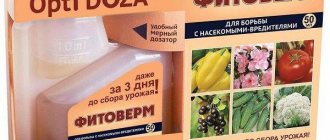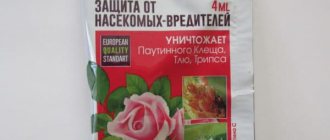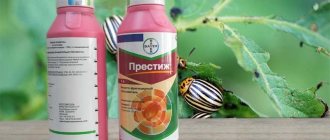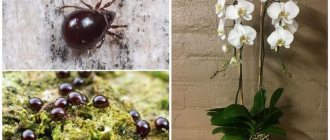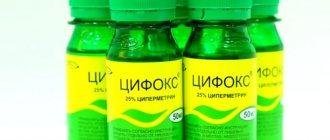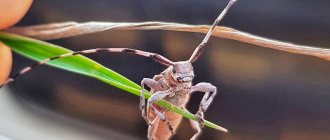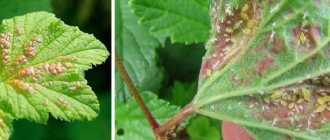Everyone knows that orchids are very fastidious plants. In addition to certain maintenance conditions (temperature, humidity, fertilizer and watering), you need to carefully ensure that the leaves or roots are not affected by various pests .
It is for these purposes that it is recommended to use the drug Fitoverm. It is toxic, so it requires the housewife to be careful when using it. How to properly dilute the drug and water an orchid? This and much more will be discussed in our article.
What kind of drug is this?
This drug is an insecticide that can cope with more than 20 types of pests.
Orchids are often affected by various pests and the drug Fitoverm is indispensable for them.
A simple and easy-to-use biological product that easily fights the most difficult to eradicate and widespread pests such as:
- thrips;
- aphid;
- spider mites and many others.
They can easily treat plants at home. Moreover, it is very convenient for home use due to the fact that it has no odor.
This is a fairly strong remedy that instantly kills insects . It does not cause environmental pollution and disintegrates very quickly in water or soil.
Reviews from flower growers about the effectiveness of Fitoverma
Review monitoring shows that Fitoverm is very actively used by lovers of indoor orchids. Moreover, with the help of this drug, orchid growers destroy even “hard-to-remove” pests:
“I read that Fitoverm is almost useless against mealybugs, but I didn’t have anything else at hand, and I decided to take a risk. I doubled the dose and diluted 2 ampoules of 2 ml each in a glass of water. First, I soaked a cotton swab in the solution and manually removed all the scale insects I saw from the phalaenopsis, wiped all the leaves, and removed all traces of pests. Then I poured Fitoverm into a spray bottle and went over the entire phalaenopsis, including the soil on top and the aerial roots. Only 10 days later I noticed a creature that had accidentally survived crawling along a leaf, killed it and sprayed everything again. A month has passed, the orchid is clean and quite healthy” (Ekaterina, Tuapse).
Indeed, due to the low phytotoxicity of Fitoverm, flower growers are not afraid to increase the concentration of working solutions. Still, it is advisable to adhere to the dosages recommended by the manufacturer, without increasing them unless absolutely necessary.
Biological products are often tested by gardeners on pests that are not listed in the instructions. Such experiments are not always successful. However, the wide spectrum of action of Fitoverma provides room for such maneuvers.
Advantages and disadvantages
The main advantage of the drug is its low danger to humans. It also has a number of other advantages.
Advantages of fitoverm:
non-phytotoxic, completely safe for plants;- quickly decomposes;
- 96-100% effective against plant mites;
- capable of operating at high temperatures;
- Can be used during flowering.
The disadvantages include:
- requires frequent and thorough processing;
- ineffective in rainy weather;
- not used with other drugs;
- does not wet leaves and flowers well;
- the cost of the drug is higher than that of other drugs.
Contraindications for use
Fitoverm is not a chemical preparation , therefore it has no contraindications for use. Safety precautions:
- Use closed clothing, gloves, goggles and a mask to protect your respiratory tract.
- Do not dilute in containers used for storing or preparing food.
- While treating the plant with the drug, you should not eat or drink, or smoke.
- After treatment, you must thoroughly wash your hands and face with soap and gargle.
- The drug is dangerous for fish and aquatic microorganisms. Do not allow the drug or packaging to get into running water.
- Dangerous for bees when spraying.
Safety precautions
The product is listed in the third class of moderately hazardous substances. Processing must occur with items of protection:
- workwear;
- respirator;
- gloves;
- glasses.
After use, the packaging should be thrown into the trash, first wrapped in a tight bag. Empty ampoules should be buried or burned away from water bodies.
First aid:
- If the product gets on your hands, feet or body, wash it off with soap and water;
- in case of contact with the eye, rinse with running water and do not cover;
- if swallowed, induce vomiting and drink activated charcoal, then consult a doctor.
Other safety measures:
- “Fitoverm” is prohibited to be sprayed near animals and children;
- store the product in a place away from people exactly according to the instructions;
- Use the solution immediately after opening the preparation package - it is not suitable for storage;
- The insecticide must not be used after the expiration date.
To prepare the active solution, use unnecessary containers. Do not dilute the substance in kitchen utensils.
Step-by-step instructions for use
Preparing plants and equipment
- Select a container for diluting the solution. It should not be used for preparing or storing food.
- Prepare the solution.
It is necessary to use a freshly prepared solution, otherwise there will be no result from such treatment. - Effective treatment is carried out in the fresh air.
- Place the plant outdoors.
- Using a sprayer, apply the solution to the plant.
How to breed?
Against aphids, use 8 ml of the drug per liter of water. Treat at weekly intervals using 100 ml per plant.- For ticks you need 10 ml per liter of liquid. Treatment interval is 7-10 days. For one plant, 100-200 ml of solution is enough.
- For thrips you need 10 ml per liter of water. Repeated treatment after a week with a solution consumption of 100-200 ml per plant.
- the soil is also treated . Prepare a solution of 4 ml of the drug per liter. The plant is placed in this solution for 20-30 minutes. Then the pests are destroyed and the soil is dried.
How to process?
Pests can attack:
- leaves;
- flowers;
- stems;
- roots.
To process an orchid, you must complete the following steps:
- Remove the plant from the pot.
- Disinfect the pot, or better yet, replace it with a new one.
- Rinse the orchid roots with hot water and treat with a solution.
- Place the plant in a wide bowl and place it in a place exposed to sunlight.
- Leave the orchid without soil for 7 days.
- Irrigate the roots with water daily.
- Keep the plant in polyethylene for the first day.
- Repeat the treatment and place the plant in the soil.
We invite you to watch a video on how to use fitoverm:
"Fitoverm": pest control
Treatment is carried out at any time of the year, in the morning. Ultraviolet light decomposes the drug. Apply the method of watering or spraying. Depending on the degree of infestation of the orchid and the type of pest, different dosages and treatment methods are used. Be sure to wipe the area where the pot with the infected flower was located.
Advice! Flower growers recommend dipping the orchid upside down in the Fitoverma solution. Leave for 1 hour. Wipe the leaf axils with a dry cloth.
Mealybug
It feeds on orchid juice. Hides on the back of leaves, in the axils, and soil. An adult reaches 5 mm. Balls that look like a piece of dirty white cotton wool appear on the orchid. Before treatment with an insecticide, parasites visible to the eye are mechanically removed using tweezers and a cotton swab. Then the roots of the plant are washed with Fitoverm. The orchid is transplanted into fresh soil, which should also be treated. To avoid the appearance of insects in the future, wipe the leaves with Fitoverma solution every 5 days.
Scale insects and false scale insects
Measuring 2 mm, the pest settles on leaves, stems, and pseudobulbs. In the process of life, it secretes a sticky substance on which the sooty fungus settles. As the parasite spreads throughout the orchid, the leaves turn yellow and fall off. The female lays up to 2000 eggs during her life. White dots and cobwebs are signs of a pest.
Using tweezers, carefully remove parasites from the plant. The orchid is sprayed with Fitoverm 2 times at weekly intervals. The roots are washed in a solution of the drug, the soil is changed. The pot is washed and doused with boiling water.
Ticks
To destroy the root mite, the orchid is taken out of the flowerpot, pieces of the substrate are taken out from the roots, then washed in warm water. Dead parts are removed, watered with Fitoverm, and the sections are sterilized. The plant is planted in new soil and a washed pot. The treatment is repeated twice at weekly intervals.
To combat spider mites and false spider mites, the orchid is sprayed with the prepared Fitoverma solution three times, with an interval of 5 days. During treatment, high air humidity is maintained in the room with the plant.
Sciarides
These fungus gnats settle in the upper layers of waterlogged soil. Getting rid of them is simple: lower the air humidity. If larvae are found in the soil, it is changed. The use of Fitoverm in this case is not necessary. However, if desired and for preventive purposes, fresh soil is watered with a solution of the drug.
Fools
The size of the insect is 0.2 mm - 1 cm. The color is white, grayish or with a greenish tint. Parasites are not dangerous for the orchid, but are an indicator of improper care of the plant. 2 ml of the drug are diluted in 50 ml of water. The orchid is watered.
Whiteflies
Pests similar to white flies can appear on the orchid. Larvae and adults feed on flower sap. They parasitize on the back of the leaf, in the soil, under the bark. As the parasites multiply, the orchid leaves turn yellow and curl into a tube.
The orchid is washed with soapy water and treated with Fitoverm. Maintain optimal humidity levels.
Thrips
Pests that are nocturnal. They settle in the ground, sucking root juices. Color black, size – up to 2.5 mm. There are two pairs of wings. Their presence is indicated by dark spots on the leaves. Conditions for appearance are low air humidity and high temperature.
Advice! Place a container with wet expanded clay next to the orchid pot. This ensures constant air humidification near the plant.
The orchid is given a warm shower, paying attention to the axils and the underside of the leaves. Next, spray with Fitoverm.
Fruit midges
They settle in waterlogged substrates. If reddish midges, 1-2 mm in size, are detected, reduce watering of the orchid. If larvae are found in the substrate, it is changed or watered with Fitoverm. The drug is also used for prevention purposes.
Aphid
As a result of its vital activity, it forms a sticky substance that is attractive to ants and fungi. The leaves turn black, curl and fall off.
Before treating with an insecticide, remove the damaged parts of the flower. The orchid is washed with soapy water. Then chemicals are used.
When can I expect results?
The effect of the drug is aimed at adults . First they stop feeding on the plant, and then they die.
Within 5-6 hours after treatment with phytoverm CE, gnawing insects still continue to feed, and they die only after 2-3 days.
Sucking pests continue to feed for 12 hours, and it takes 5-6 days to completely destroy them.
Outdoors, the drug can remain on the plant for up to 3 weeks , provided there is no precipitation. In open ground, the effect occurs faster (in 3-4 days). But on indoor plants, you need to wait from 5 to 7 days to get the effect.
How to treat orchids?
The treatment method depends on the type of insect. If they live on leaves and stems, the plant is sprayed with a spray bottle 4 times a day for two weeks. Between sprayings take a break of two days.
When infested with pests that parasitize the root system, treatment is more difficult:
- The orchid is removed from the pot.
- Wash the roots in hot water.
- They are treated with Fitoverm solution.
- The flower is carefully placed in a basin or bowl and put away in a shaded place.
- Keep the plant without soil for 7–10 days, periodically spraying the roots.
- After the end of the specified period, repeat treatment with the toxin solution.
After this, the orchid is planted in a new, uninfected substrate. Before this, the pot is thoroughly washed and treated with disinfectants. These measures help avoid repeated pest attacks.
